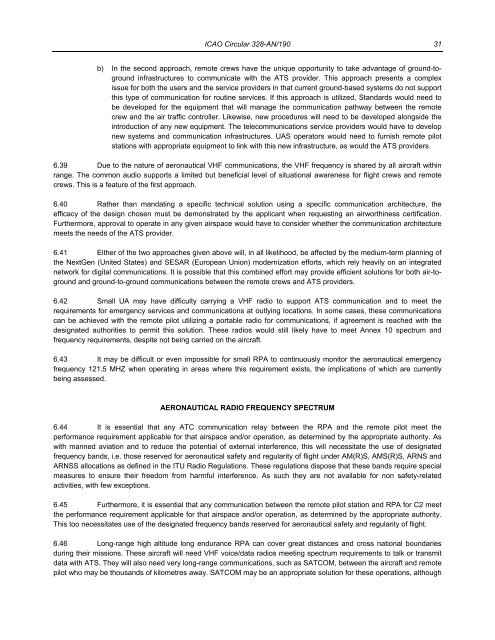Circular 328_en
Circular 328_en
Circular 328_en
You also want an ePaper? Increase the reach of your titles
YUMPU automatically turns print PDFs into web optimized ePapers that Google loves.
ICAO <strong>Circular</strong> <strong>328</strong>-AN/190 31<br />
b) In the second approach, remote crews have the unique opportunity to take advantage of ground-toground<br />
infrastructures to communicate with the ATS provider. This approach pres<strong>en</strong>ts a complex<br />
issue for both the users and the service providers in that curr<strong>en</strong>t ground-based systems do not support<br />
this type of communication for routine services. If this approach is utilized, Standards would need to<br />
be developed for the equipm<strong>en</strong>t that will manage the communication pathway betwe<strong>en</strong> the remote<br />
crew and the air traffic controller. Likewise, new procedures will need to be developed alongside the<br />
introduction of any new equipm<strong>en</strong>t. The telecommunications service providers would have to develop<br />
new systems and communication infrastructures. UAS operators would need to furnish remote pilot<br />
stations with appropriate equipm<strong>en</strong>t to link with this new infrastructure, as would the ATS providers.<br />
6.39 Due to the nature of aeronautical VHF communications, the VHF frequ<strong>en</strong>cy is shared by all aircraft within<br />
range. The common audio supports a limited but b<strong>en</strong>eficial level of situational awar<strong>en</strong>ess for flight crews and remote<br />
crews. This is a feature of the first approach.<br />
6.40 Rather than mandating a specific technical solution using a specific communication architecture, the<br />
efficacy of the design chos<strong>en</strong> must be demonstrated by the applicant wh<strong>en</strong> requesting an airworthiness certification.<br />
Furthermore, approval to operate in any giv<strong>en</strong> airspace would have to consider whether the communication architecture<br />
meets the needs of the ATS provider.<br />
6.41 Either of the two approaches giv<strong>en</strong> above will, in all likelihood, be affected by the medium-term planning of<br />
the NextG<strong>en</strong> (United States) and SESAR (European Union) modernization efforts, which rely heavily on an integrated<br />
network for digital communications. It is possible that this combined effort may provide effici<strong>en</strong>t solutions for both air-toground<br />
and ground-to-ground communications betwe<strong>en</strong> the remote crews and ATS providers.<br />
6.42 Small UA may have difficulty carrying a VHF radio to support ATS communication and to meet the<br />
requirem<strong>en</strong>ts for emerg<strong>en</strong>cy services and communications at outlying locations. In some cases, these communications<br />
can be achieved with the remote pilot utilizing a portable radio for communications, if agreem<strong>en</strong>t is reached with the<br />
designated authorities to permit this solution. These radios would still likely have to meet Annex 10 spectrum and<br />
frequ<strong>en</strong>cy requirem<strong>en</strong>ts, despite not being carried on the aircraft.<br />
6.43 It may be difficult or ev<strong>en</strong> impossible for small RPA to continuously monitor the aeronautical emerg<strong>en</strong>cy<br />
frequ<strong>en</strong>cy 121.5 MHZ wh<strong>en</strong> operating in areas where this requirem<strong>en</strong>t exists, the implications of which are curr<strong>en</strong>tly<br />
being assessed.<br />
AERONAUTICAL RADIO FREQUENCY SPECTRUM<br />
6.44 It is ess<strong>en</strong>tial that any ATC communication relay betwe<strong>en</strong> the RPA and the remote pilot meet the<br />
performance requirem<strong>en</strong>t applicable for that airspace and/or operation, as determined by the appropriate authority. As<br />
with manned aviation and to reduce the pot<strong>en</strong>tial of external interfer<strong>en</strong>ce, this will necessitate the use of designated<br />
frequ<strong>en</strong>cy bands, i.e. those reserved for aeronautical safety and regularity of flight under AM(R)S, AMS(R)S, ARNS and<br />
ARNSS allocations as defined in the ITU Radio Regulations. These regulations dispose that these bands require special<br />
measures to <strong>en</strong>sure their freedom from harmful interfer<strong>en</strong>ce. As such they are not available for non safety-related<br />
activities, with few exceptions.<br />
6.45 Furthermore, it is ess<strong>en</strong>tial that any communication betwe<strong>en</strong> the remote pilot station and RPA for C2 meet<br />
the performance requirem<strong>en</strong>t applicable for that airspace and/or operation, as determined by the appropriate authority.<br />
This too necessitates use of the designated frequ<strong>en</strong>cy bands reserved for aeronautical safety and regularity of flight.<br />
6.46 Long-range high altitude long <strong>en</strong>durance RPA can cover great distances and cross national boundaries<br />
during their missions. These aircraft will need VHF voice/data radios meeting spectrum requirem<strong>en</strong>ts to talk or transmit<br />
data with ATS. They will also need very long-range communications, such as SATCOM, betwe<strong>en</strong> the aircraft and remote<br />
pilot who may be thousands of kilometres away. SATCOM may be an appropriate solution for these operations, although


